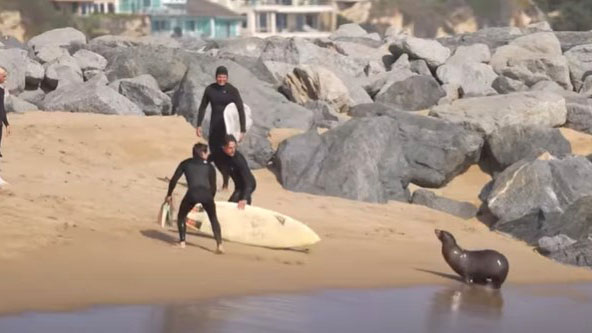The situation at first seemed comical – a cute little sea lion ruling the line up at the wild Wedge in Newport Beach, where wave riders showed up earlier this week to take on beefy waves from the first south swell of the season.
At times, the sea lion would join in on the fun, bodysurfing a few waves and playing in the surf like the others in the water. It’s not an unusual scene, the marine mammals are known for their playfulness while hanging out near surfers.
RELATED: Why are sea lions attacking people in the waters off California’s coast?
But there was something off about this one — it would suddenly turn aggressive, chasing the humans out of the water, darting toward them.
The encounter occurred on April 15 at the Wedge, a popular surf spot on the east end of the Balboa Peninsula. The sea lion “spooked all the surfers and bodyboarders” and was “chasing them in an aggressive fashion,” said Brian O’Rourke, assistant chief lifeguard with Newport Beach Fire.
It went on for hours, a local photographer videoing the scene of the frantic surfers exiting the water as the aggressive sea lion approached.
The aggressive sea lion in Newport Beach is believed to be suffering from domoic acid poisoning, a toxin affecting sea lions, birds and dolphins throughout Southern California. Public safety officials have been warning beachgoers to stay away from animals found stranded on the beach because they can become aggressive.
Related Articles
Tick-borne diseases skyrocket. Protect yourself before it’s too late
Commercial salmon season is shut down — again. Will California’s iconic fish ever recover?
New $50 million high-tech ship arrives to unlock ocean mysteries
Watch: During Monday’s quake, elephants form ‘alert circle’ at San Diego Safari Park
What animal turned my car into a prickly pear pantry?
The domoic acid poisoning is believed to be from toxic algae blooms, which since late February have impacted a large swath of marine mammals, which after eating contaminated fish become sick, disoriented and often wash ashore. Marine mammal rescue centers have been overwhelmed keeping up with the sickened animals that have stranded on beaches from Orange County to Ventura County.
Video footage shared by user DingoSaidSo shows a group of more than a dozen surfers at the Wedge on Tuesday quickly paddling to shore as the sea lion follows, not far behind. In another clip, the sea lion chases another surfer as he tries to swim away.
“This could have been one of the wildest things I’ve ever seen at The Wedge, and I’ve seen a lot of crazy things at The Wedge,” he wrote.
In an interview following the incident, the photographer, who did not want to be named, said he didn’t realize the severity of the moment until he later learned about all the other aggressive sea lion incidents.
“It was just hanging out, bodysurfed a few waves. But anytime someone would get in the water, it would go after them. Then it would disappear, it would go off and lose track and everyone would go back in the water,” he recounted. “Next then you know, you’d see everyone kicking into shore, trying to out run it. It was really kind of crazy.”
At first, it seemed “harmless and funny,” but as he heard stories of other aggressive sea lion incidents, he realized the severity of the situation.
State Parks Superintendent Kevin Pearsall said there’s been three reports of aggressive sea lions in Orange County, two at Bolsa Chica State Beach and the most severe at Crystal Cove on April 4.
In that incident, a bodysurfer was bit by a sea lion, other people and two lifeguards jumping into action to try and get the creature away from the victim, a male in his 20s who was transported to the hospital.
“It was very abrupt,” Pearsall said. “Just like any animal, you want to use extra caution around them – especially if their behavior appears to be aggressive. Admire the sea lions from afar, everyone is always curious about sea life, but you have to be extra cautious because of the unknown domoic acid effects and how it might alter their behavior.”
A surfer, RJ LaMendola, in Oxnard recounted an attack late March after a sea lion bit him and sent him to the hospital.
In updates on social media, the surfer said the attack has left him “shaken and battling PTSD,” but he holds no anger toward the creature.
“I love nature, especially our marine wildlife, and I’ve spent my life advocating for the ocean through my photography,” he said. “Something’s wrong. I have been working with local scientists and news media, doing my own research to understand what’s causing this. That sea lion wasn’t itself, likely poisoned by domoic acid from toxic algae blooms.”
The Newport Beach photographer who captured the Wedge footage echoed those same thoughts.
“I don’t know if people understand the seriousness of the situation with these sea lions. These kids didn’t know,” he said of the surfers at the Wedge. “They didn’t know sea lions are biting and attacking people. We can do a better job making this a serious issue. It was gnarly hearing all these stories.”
The toxic algae poisoning was recently linked to a random sea lion attack in Long Beach, where a teenage girl was bit several times while in the water swimming in a tryout for the local lifeguard cadet program.
“With Spring Break right now, there’s a lot of people on the water,” O’Rourke said. “We want to make sure people understand that (the sea lions) are sick and to keep a distance.”
If you encounter a sick sea lion, contact lifeguards or the Pacific Marine Mammal Center at 949-494-3050





